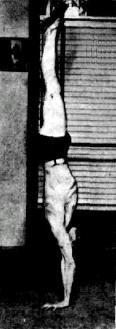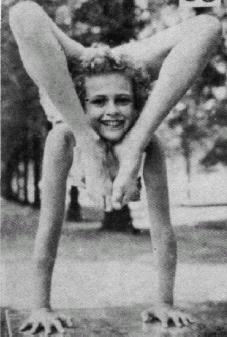A common question that anyone starting in hand balancing asks is what kind of handstand should I try to do? By this they are referring to the position of the back during the hand balance. Because what you do with your back has the biggest impact in the look of your handstand. There are two types that are common today, the natural arch in the back and a straight bodied handstand.
 First a little bit of history so that you can understand why there is a rift between the two. Back in the early years of the 20th century, and before that as well, the common position in which to hold a handstand was with a natural curve and the head facing toward the ground. Even in gymnastics of the past this was the common style.
First a little bit of history so that you can understand why there is a rift between the two. Back in the early years of the 20th century, and before that as well, the common position in which to hold a handstand was with a natural curve and the head facing toward the ground. Even in gymnastics of the past this was the common style.
The straight style of handstand that is so prevalent today did exist, but this was a more advanced move to learn later on. It was favored by some especially for hand-to-hand balancing.
At some point, I believe in the 70’s, gymnasts started to move exclusively toward to this straight style. In fact these days they specifically train this position to the exclusion of the other. Why did this happen? To the Olympic Judge this style is more pleasing to the eye being in a single straight line. Because of the rigidity it will also allow more difficult tricks to be performed on the various apparatus as well as tumbling on the floor.
 Does that mean the old style of the arched back should be forgotten? Not at all. It is still valid today as it was a century ago. If you were to ask someone who had never done a handstand before to jump into one, this would be the position they would go after.
Does that mean the old style of the arched back should be forgotten? Not at all. It is still valid today as it was a century ago. If you were to ask someone who had never done a handstand before to jump into one, this would be the position they would go after.
In fact, Bob Jones recommends that you use all of your back bend when learning because it is easier to do so. You can read more about his opinions on this in The True Art and Science of Hand Balancing. (Note: All the pictures on this page are from this book.) This isn’t to say the rest of the balance can be sloppy, in fact he is a stickler for perfection, only that arch in the back is up to the individual doing the handstand.
If you have ever watched a contortionist they can arch their back to the point where they can hold a handstand and bring their feet down to their chin. Some can even sit on the back of their own head! Now that is some arch.
What makes it easier? For one you have a lower center of gravity. Also you are able to use more of your musculature to hold the position.
 Some people complain of pain or aches in their low back when they use arch. To combat this you can do a number of things. You want to make sure that you remain tight while you are arching. If you relax while arched, gravity can pull your legs further than they normally go causing some strain. If you keep tight then your feet and legs will not pull on your back excessively.
Some people complain of pain or aches in their low back when they use arch. To combat this you can do a number of things. You want to make sure that you remain tight while you are arching. If you relax while arched, gravity can pull your legs further than they normally go causing some strain. If you keep tight then your feet and legs will not pull on your back excessively.
Another thing is to just work up to however much hand balancing you are doing. Overtime you back will become use to the volume of work.
Start with the easier method and later when you have become proficient in it then you can and should work on being able to manipulate your legs, spine, body, and head while in a hand balance and still remain up there.
A straight position require great shoulder flexibility and a finer sense of balance especially if the head is brought down between the arms. A move to be mastered some time after you are competent at the normal arched handstand.
In Hand Balancing Made Easy, Professor Orlick lists a number of positions for you to work through. When you can balance in all of these you are really on your way to becoming a great hand balancer. He believed you should have some arch in your normal handstand but not excessive, unless you were specifically going for that trick.
In the end it is up to you which style you prefer to go after and use most of the time. Unless you are a competing gymnast I would start of with the natural curved style. But how much you arch is entirely up to you. Of course you should perfect all styles in the end.
And whatever handstand positions you choose, all of the fundamentals still apply.
